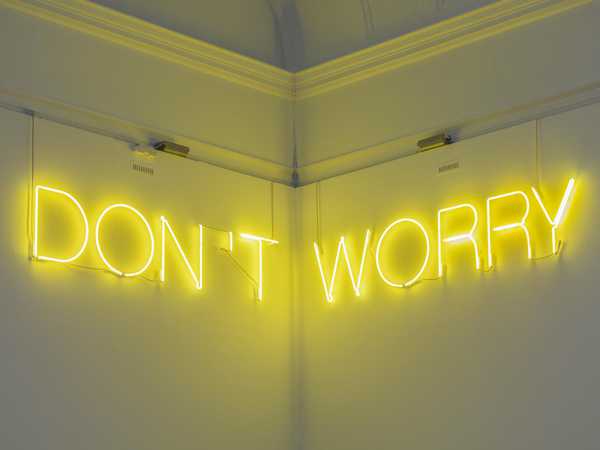Beyond the White Walls
2012 - Film & Video (Film & Video)
26 min 11
Jeremy Deller
Beyond the White Walls , with a commentary written and spoken by Jeremy Deller, is often wryly amusing. The artist narrates the many projects he has completed or which are in progress beyond the gallery walls. It is beyond the gallery where Deller is at his most effective and where his art reaches out to and into people’s lives. The tape slide presentation shows the extensive range of Deller’s work. On one level it is documentation, on another level it is a work that investigates the nature of a work of art – is a social project a work of art? When does documentation become art? Can we accept the artist’s commentary at face value? The artist acts as a historian or archivist of his own work but presents it in such a way that the archive is the work of art itself. Deller is at one and the same time artist, curator and cultural historian interested in the way popular culture and fine art abut each other. His art has the capacity to affect directly people’s lives by inserting it into the community and requiring the community’s participation.
Jeremy Deller is one of the leading British artists working in film and making projects that grow out of an interest in vox pop, giving vent to the views of ordinary people and focusing on ordinary people’s lives. He seeks the involvement of the common man in the making of his work as well as focusing on events that have had a major impact on people’s lives. His most famous piece is a film called the Battle of Orgreave (2001) in which he produced and filmed a reenactment of an infamous confrontation between striking miners and the police force during the fateful miners’ strike that took place during Margaret Thatcher’s first term in office in 1984. In Deller’s restaging many of the participants were miners and policemen who had been present at the original event. Prior to that in 1996 Deller produced a work called Acid Brass for which he commissioned a brass band from the northern community of Stockport that would normally play traditional and often Christian songs, to play acid house and techno rock tunes. Brass Bands were closely associated with the collieries that were under threat from the conservative government’s closure of the coalmines. For Deller the Miners’ strike and the rise of acid house music were the two most significant events of the period and he brought them together in this one piece. It is the mixing of traditions that makes his work so compelling. Deller went on to win the Turner Prize in 2004 and has continued to make works which investigate the interface between art and popular culture, normally with a strong political and social aspect, although often the works are funny and witty. In 2012 his solo exhibition at the Hayward Gallery was widely acclaimed.
Colors:
Related works featuring themes of: » British

© » KADIST
Keith Tyson
The work of Keith Tyson is concerned with an interest in generative systems, and embraces the complexity and interconnectedness of existence...

© » KADIST
Ryan Gander
2012Epiphany…learnt through hardship is composed of a bronze sculpture depicting the model of the little dancer of Degas, in the pose of a female nude photographed by Edward Weston (Nude, 1936) accompanied by a blue cube...

© » KADIST
Rosalind Nashashibi
2019Rosalind Nashashibi’s paintings incorporate motifs drawn from her day-to-day environment, often reworked with multiple variations...

© » KADIST
Simon Fujiwara
2016Masks is a series of abstract paintings by Simon Fujiwara that together form a giant, fragmented portrait of German Chancellor Angela Merkel’s face...

© » KADIST
Mark Leckey
2004In Made In Heaven , we are face to face with a sculptural apparition, a divine visitation in the artist’s studio...

© » KADIST
Tacita Dean
2001The photographic quality of the film Baobab is not only the result of a highly sophisticated use of black and white and light, but also of the way in which each tree is characterized as an individual, creating in the end a series of portraits...

© » KADIST
Simon Starling
2007Invited in 2007 to the Museum Folkwang in Essen (Germany), Simon Starling questioned its history: known for its collections and particularly for its early engagement in favor of modern art (including the acquisition and exhibition of works by Cézanne, Gauguin, Van Gogh, Matisse), then destroyed during the Second World War, the museum was pillaged for its masterpieces of ‘degenerate art’ by the nazis...

© » KADIST
Martin Boyce
2003In the installation Our Love is like the Flowers, the Rain, the Sea and the Hours, Martin Boyce uses common elements from public gardens – trees, benches, trashbins– in a game which describes at once a social space and an abstract dream space...

© » KADIST
Andrew Grassie
2009In 2008, Grassie was invited by the Whitechapel Gallery to document the transformation of some of its spaces...

© » TATE EXHIBITIONS
Martin Creed
Martin Creed | The Dick Institute Experience the work of one of this country’s most ingenious, audacious and surprising artists at the Dick Institute ARTIST ROOMS Martin Creed presents highlights from the British artist’s thirty-year career...

© » KADIST
Ian Wallace
1986Wallace says of his Heroes in the Street series, “The street is the site, metaphorically as well as in actuality, of all the forces of society and economics imploded upon the individual, who, moving within the dense forest of symbols of the modern city, can achieve the status of the heroic.” The hero in Study for my Heroes in the Street (Stan) is the photoconceptual artist Stan Douglas, who is depicted here (and also included in the Kadist Collection) as an archetypal figure restlessly drifting the streets of the modern world...









